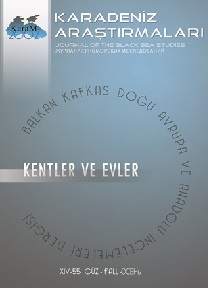Tarihi Çorum Evlerinin Alçı Süslemeleri
Plaster Decorations for the Historical Houses in Çorum
Author(s): Necla DursunSubject(s): Cultural history, Architecture, Visual Arts, Local History / Microhistory, The Ottoman Empire
Published by: Karadeniz Araştırmaları Merkezi
Keywords: Corum; Historical Corum Houses; Plaster Decorations; Traditional Houses; Decorations;
Summary/Abstract: Corum is an important city who has hosted many civilizations throughout the history. From the earliest settlement times the city has conserved its strategic location to this day. There have been carried out new zoning activities in almost every period the city was used. During the Anatolian Seljuk period, several constructions have been made in the region. However, most of the abrogated structures which are standing today belong to the Ottoman period. Remaining from the Ottoman period, within the group as civil architecture important works such as mosque, prayer rooms, madrasa, dargah, hammam, etc. are important works that has reached the day. The traditional Corum houses are basically constructed as single or double buildings. There are also large mansions in the city consisting of courtyards triple story’s outbuildings and service places built by the authorities in the Ottoman organization by the city’s leading figures. In the historical houses, the architectural ornamentation is mainly concentrated on wood, together with certain architectural elements, it is possible to say that it is in a quality to complete with examples in the capital style. It is seen that the decorative elements seen especially in the palace architecture during the Ottoman period were made in this region houses in a way that conforms to the period style. The subject of this article is the determination and interpretation of the plaster decorations used in the traditional mansion and houses in the center of Corum. In the samples to examination within this research, plaster was used in quarries, hearths, flower beds, lanterns and chimney covers. The ornaments seen on these units are samples of foreign decorative motifs such as baroque and rococo provincial examples seen in the capital during the late Ottoman period. The purpose of the work is to introduce the different use of the plaster material in different areas, the decoration motifs, period features and iconographic interpretations within the framework of Art History discipline which are seen in the formation and decoration of the architectural elements of traditional Turkish houses and mansions in center of Corum.
Journal: Karadeniz Araştırmaları
- Issue Year: 2017
- Issue No: 55
- Page Range: 1-16
- Page Count: 16
- Language: Turkish

